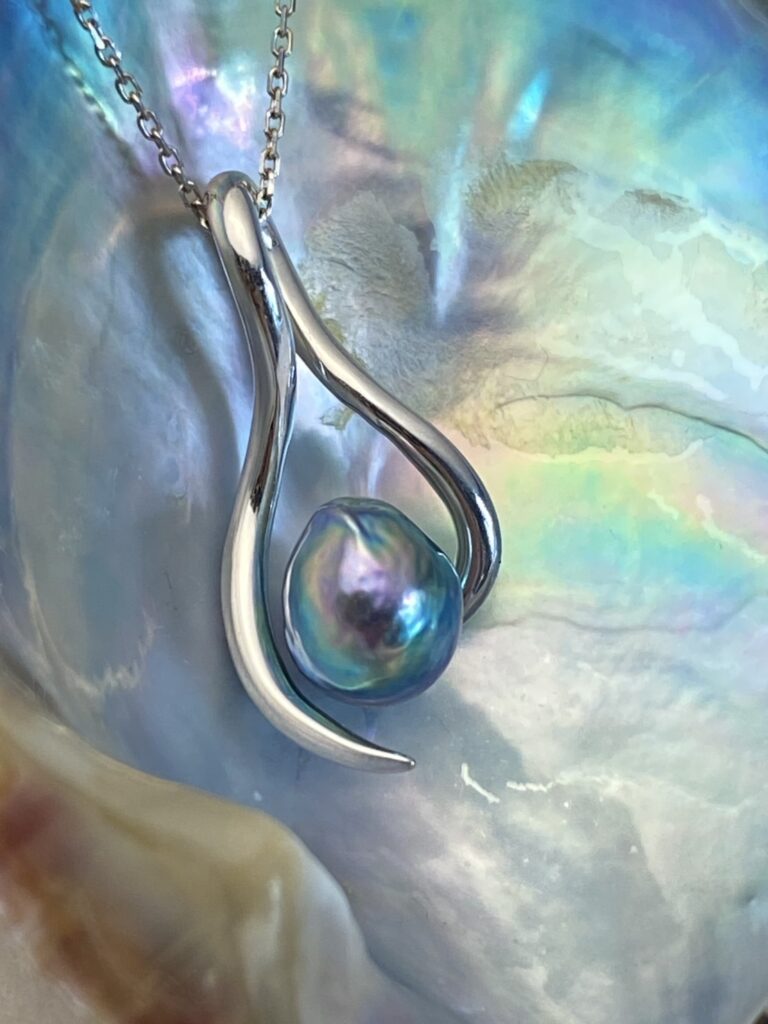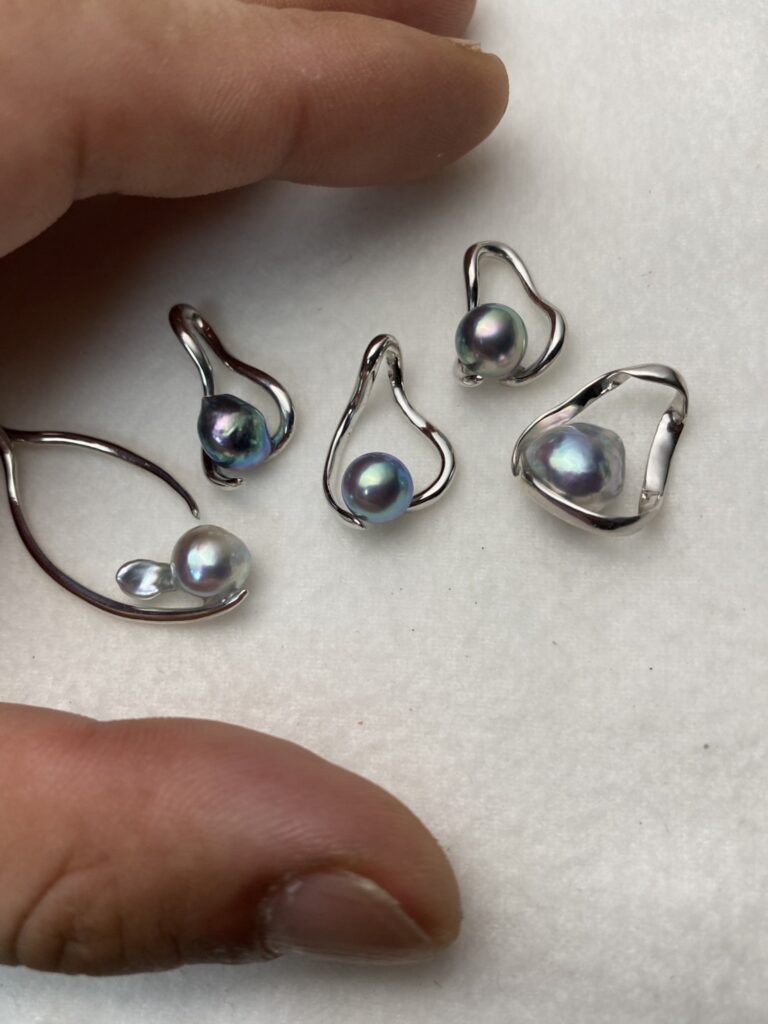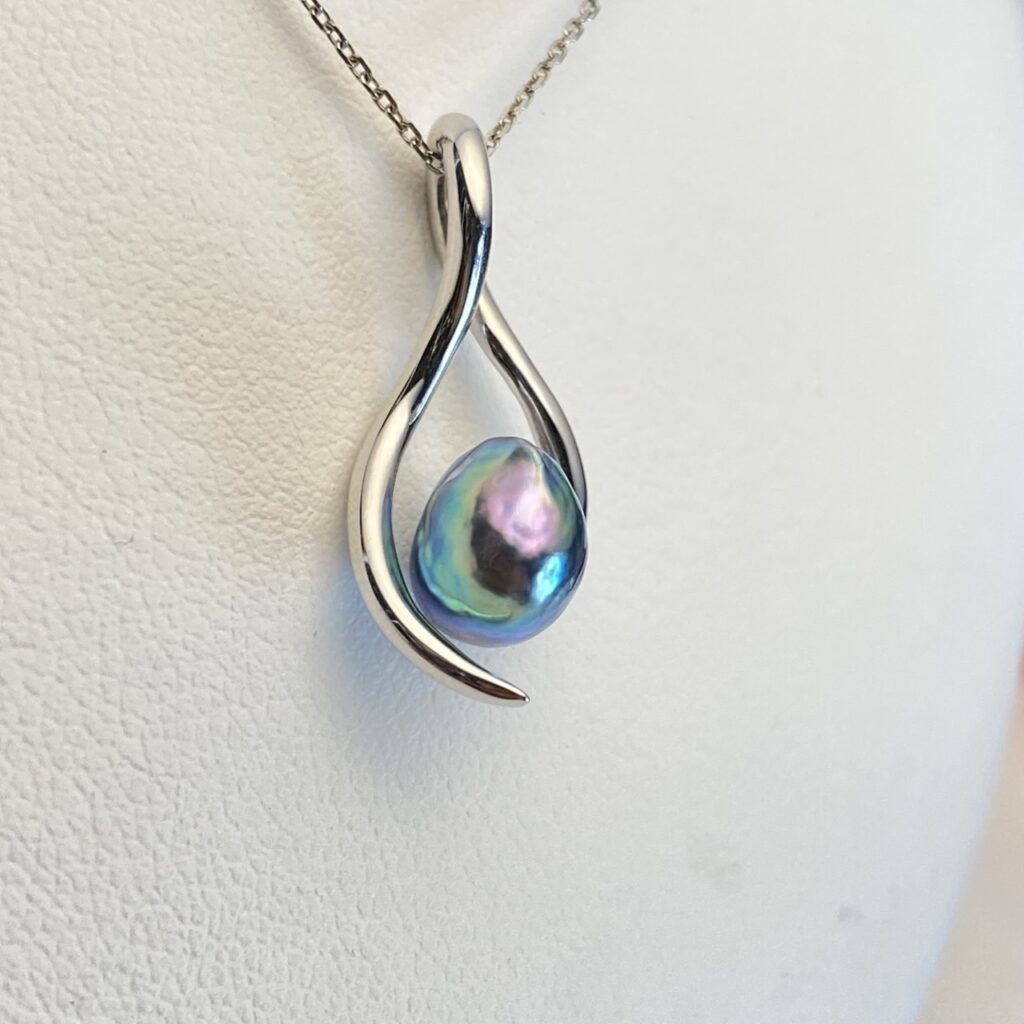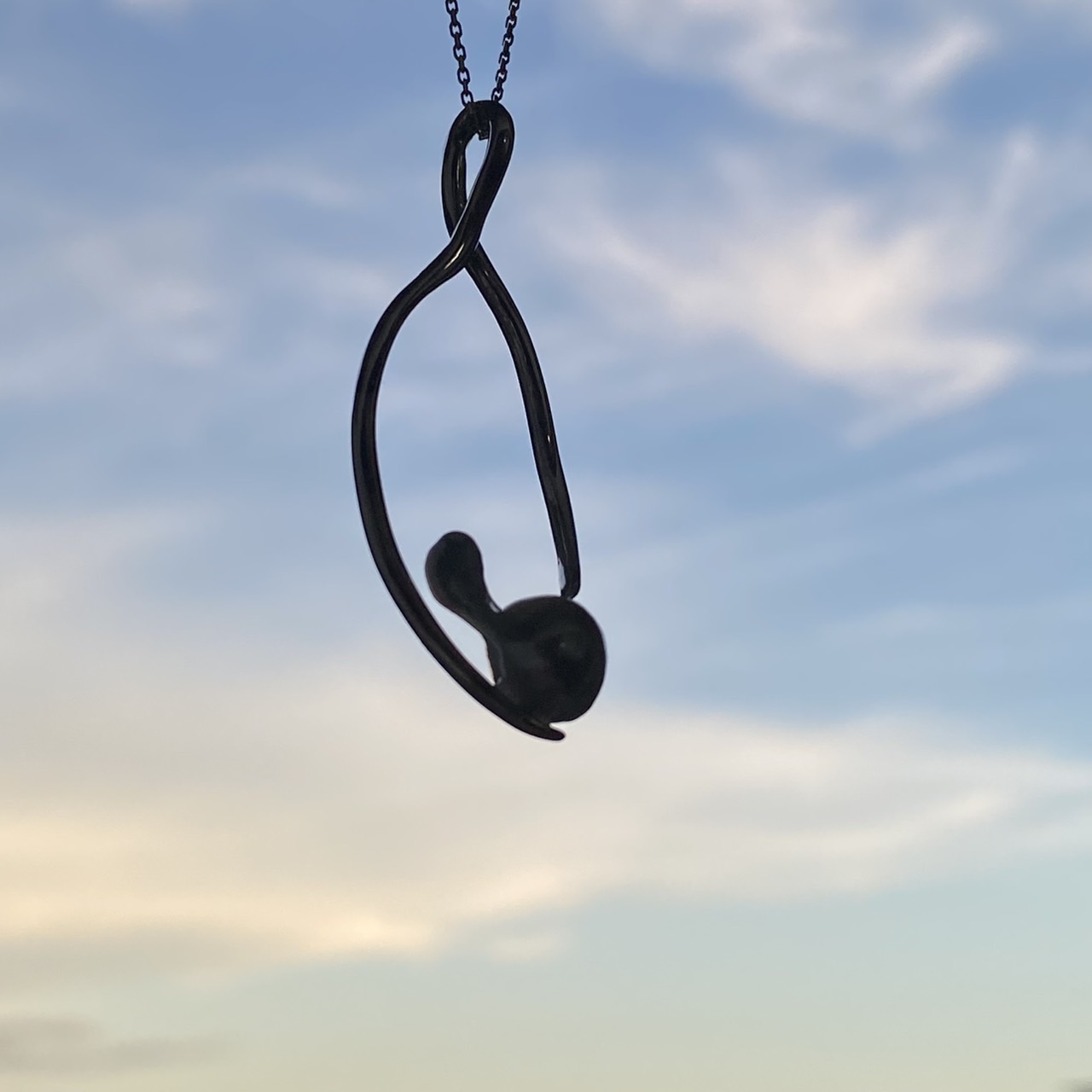A Long-Awaited Update – And an Unexpected Honor from GIA
It’s been quite a while since my last blog post.
Here in Japan, we are in the midst of summer—each day warmer than the last, with the heat clinging to everything.
As for me, my life continues in its usual rhythm: weekdays are spent working in a field completely unrelated to pearls, while weekends are dedicated to pearl work. However, in June, I had to work three consecutive Saturdays as part of my weekday job. That meant losing half of my precious weekends—a serious blow for someone like me, who treasures every moment spent with pearls.
My business is already quite small, and when even the time to work with pearls is taken away, it becomes especially difficult to keep going.

Despite that, something truly encouraging and deeply meaningful happened to me recently.
Just last week, I received an inquiry from none other than GIA in the United States.
They reached out to ask me several questions about Akoya pearl farming.
Even more astonishing, they also requested permission to use the photos and videos I personally took of Japanese pearl farms.
There’s a chance that my footage may be used in their course materials or educational content.
Although my website has been gradually gaining visitors, it’s still relatively small. So to be contacted by someone who is genuinely seeking in-depth information about pearl cultivation—it means the world to me.
What’s more, the questions they asked were fascinating, and I learned a great deal just by thinking carefully about how to answer.
With the person’s kind permission, I would now like to share those questions with you.
1 I suppose that all farms also breed their own Akoya mollusks, is that still the case in Japan?
2 Are there farms that are specialized at breeding and supply spats or mature mollusks to pearl farmers?
3 About how many farms are actively culturing in Japan these days? The number has changed over the past decade? Especially after Pandemic?
4 I read your article about the Indonesian workers helping in akoya farms. When did this start to happen in Japan? Workers from any other pearl producing areas such as Philippines, Vietnam?
5 I read that some farms begin to nucleate the mollusks at their 1 year mark, other will do it at about 1.5 years, therefore 1-1.5 years would be the range before nucleation?
6 In our old textbook, it says that 1-4 beads are inserted into the mollusk, is this still correct in Japan?
7 If more than beads are inserted, are they all inserted into one area such as the mantle or gonad? OR they are inserted in to both areas at the same time? Any other organs in the visceral sac is used for culturing other than gonad?
8 I see the two potential periods during the year that nucleation happens. The 1-year pearl is basically cultured a little less than a year usually, is that correct? Is there a minimum amount of time or thickness of nacre that has to be met by the Japanese akoya farmers?
9 The post-harvest processing is mainly aiming to clean the surface of the pearl and remove any attached flesh or stains?
10 If the pearls are treated beyond post-harvest processing, they are treated in Japan? Or usually somewhere else?
Reflections on Time, Craft, and a Surprising Message from GIA
Reading the questions I received from GIA gave me a deep appreciation for their level of knowledge about Akoya pearls—and also highlighted the gaps between academic understanding and real-world practice. I found the experience genuinely fascinating.
Although I’ve only been involved in the Akoya pearl industry for about ten years, I’ve accumulated a fair amount of hands-on experience. Many of those insights have already been shared here on my blog. Of course, it’s one thing to share what I know on my own terms—but answering well-considered questions from others can be a powerful way to bring forward specific information that might otherwise remain buried.
There were ten questions in total, and I’ve already responded in two parts.
Since the answers turned out to be quite long, I hesitated about whether to include them in full here. But given my sporadic posting schedule, I decided to share my responses to questions 1 through 6 at the end of this article. Please be aware: the content is highly technical, and the total word count exceeds 10,000 characters. Read on only if you’re ready for a deep dive.
Now, let me shift gears for a moment.
As I mentioned earlier, I’ve been struggling to make time for pearl work lately—June was especially tough, with only one free day per week to devote to it.
Even so, I continued working, little by little, on my Hold series of handmade metalwork pendants.
Just yesterday, I finally listed the 4th through 8th pendants in that series on Etsy.
They’re simple in design, and though I started crafting them back in late May, it wasn’t until mid-July that I managed to finish and list them. That timeline makes me nervous—this pace doesn’t exactly make for a viable business model.
Still, I really want to learn and develop my metalworking skills.
I’m nowhere near the level of a professional jeweler. I can’t set diamonds or create intricate pieces. My pendants are very simple. And to be honest, I’m not trying to create something “one of a kind” in the conventional sense.
Even if an item exists in abundance, if someone feels a connection to it, it can become truly unique in their eyes.
Conversely, even if something is the only one in the world, it has no value if it means nothing to you. Things exist—and simultaneously don’t—depending on how we relate to them.
That’s why, for me, the phrase “one of a kind” doesn’t carry the same weight it used to. It’s become so overused in marketing that it no longer resonates.
I understand the appeal of wanting something no one else has.
But personally, I prefer the mindset of: “It doesn’t matter who else has it—I want this.”
If your desires are always tied to what others do or don’t own, then your preferences aren’t truly your own.
That’s not how I want to live or create.

With that belief in mind, I made these pendants.
I told myself:
“The world is vast. Somewhere out there, someone may already have made something similar to what I’m creating now. But that’s not the point. With the skills I have now, the feelings I carry now, and the environment I’m in now—I’m making what I want to make.”
And in the end, I’m satisfied. I created something I like.
Still, I can’t deny feeling uneasy about how much time I spent making just five pendants.
That tension—between creating what I want and producing something that sells—has weighed heavily on me.
It made me think deeply about the balance between artistry and business.
If I keep making things without regard for profit, that’s just a hobby. But constantly chasing what’s likely to sell is equally exhausting.
And the more you do that, the more you risk slipping into the territory of mass-market, low-priced pearl goods.
I spent a lot of time reflecting on this while working at the bench.
And finally, I came to a conclusion:
I’ll keep making the pieces I truly want to make.
But I’ll also begin offering more accessible pearl products—simple, affordable pieces that still meet a reasonable standard of quality.
Akoya pearl prices have soared recently—many necklaces now cost twice what they did just a few years ago.
Yet many customers’ sense of appropriate pricing hasn’t changed. There’s a noticeable gap.
So from now on, I’ll continue offering high-quality pearls, but I’ll also experiment with necklaces in the more familiar price ranges that many customers are looking for.
It’s a tricky balancing act.
There are countless books, videos, and online courses about marketing strategy these days.
But I’m no expert in that field.
Instead, I plan to move forward based on personal experience.
There will be a lot of trial and error—and for a while, I probably won’t find the “right answer.”
But I’m okay with that. I’ll grow by failing in the right way.
It’s been about five years since I started Flower Jem.
These days, I’ve begun exchanging messages with more and more customers around the world.
Many of them found me through my pearls. But now we talk about all kinds of things—beyond just jewelry. That makes me incredibly happy.
It doesn’t feel like our relationship depends on pearls to stay meaningful.
And for those customers, I want them to feel like they made a truly special purchase.
To think, “I bought these pearls from a wonderful little shop.”
Maybe that’s just my own personal wish—but I can’t help it.
While I was making these five pendants, somewhere deep inside me, I felt a constant pressure.
It was like pouring water into a bathtub with the drain unplugged—no matter how much I did, that unease never quite went away.
Even though I was making something I genuinely liked.
When I finally finished and listed the last pendant, that vague anxiety took a more concrete form.
I thought I’d be overwhelmed with joy—but instead, I felt half joy, half worry.
Looking back, the reason seems obvious.
I’m the kind of person who just jumps in—like sticking your hand into fire and only then realizing it’s hot.
So yes, this post has meandered quite a bit.
I initially set out to write about GIA’s questions in detail…
but somehow ended up on a completely different path.
That’s just how things tend to go at Flower Jem.
Anyway, if you’ve made it this far and still have time, I’ve included my responses to GIA’s questions 1 through 6 below.
Thanks, as always, for reading.
****************************************************************
- Are all pearl farms in Japan still breeding their own Akoya mollusks?
In reality, more than half — perhaps most — of the farms purchase their mother mollusks from external sources. The main suppliers are specialized mother mollusk breeders in Uwajima City, Ehime Prefecture.
Uwajima has a unique history. In 1957, the prefectural government established a policy to separate the operations of mother shell breeding and pearl cultivation to coordinate production between local fishermen and pearl companies from outside the region. This separation of roles — known as the “Ehime Method” — is a key characteristic that sets Uwajima apart from other pearl-producing regions such as Ise and Kyushu.
The high-quality mother mollusks raised in specialized farms in Ehime are purchased by pearl farmers across Japan, including Ise and Kyushu. Until about 7–10 years ago, Uwajima produced an abundance of excellent mollusks, each with their own recognized brand names. Some pearl companies specifically sought out these mollusks, believing they were essential to producing high-quality pearls.
However, these mollusks were also inbred over many generations. In the past, there were successful efforts to introduce new Akoya strains from China, but in recent years, no new promising strains have emerged. As a result, inbreeding continued over a long period. Some believe this prolonged inbreeding contributed to the mass mortality events that struck Akoya pearl farms during the pandemic.
Additionally, over the past 10–15 years, Akoya mollusks have virtually disappeared from the waters where they once thrived. In their place, black-lipped oysters have become more common. In the past five years, mass mortality events and slowed growth have been observed among Akoya mollusks — likely due to changes in the marine environment. In some areas where over 3 million wild spats could be collected annually just a decade ago, the number has dropped to below 200 today.
It is now rare for individual pearl farms to successfully collect and raise Akoya spats on their own. One pearl company had been collecting spats consistently for years, but even they have struggled to meet their targets in recent years.
Aside from the well-known breeders in Uwajima, there are other private companies engaged in spat production — including those spun off from the seedling divisions of Mikimoto and Tasaki, as well as Otsuki Pearl. Among these, the spat breeder founded by former Tasaki employees is one of the largest and most respected in the country. They use scientific and biological approaches to ensure reliable spat production. Many pearl companies supply them with a few dozen to a few hundred selected adult mollusks each year, from which hundreds of thousands or even millions of spat are produced.
These breeders sometimes express frustration with pearl farmers, who often lack biological knowledge. For example, they may ignore Mendel’s laws and request unreasonable pairings. These biologically unsound practices, they say, have contributed to the recent mollusk die-offs. Ironically, these events coincided with the human pandemic — and both may reflect similar patterns of imbalance. Some even argue that the absence of regulatory oversight for marine species crossing or breeding has played a role in this crisis.
In addition to the host mollusks, another critical element is the donor tissue — known as “saibou-kai” in Japanese. These donor mollusks are used to provide the epithelial cells inserted along with the nucleus. Like the mother mollusks, these donor mollusks are also typically purchased from outside suppliers, with many of them based in Ise. The pairing of donor and host is crucial for producing quality pearls.
To summarize: today, the majority of pearl farmers in Japan rely on externally sourced Akoya mollusks. The reasons include labor shortages, difficulties in spat collection, a desire to focus on pearl production, and the availability of high-quality mother shells from specialist breeders.
- Are there farms that specialize in producing and supplying spat or mature mollusks to pearl farmers?
This is essentially covered in my answer to question 1, but I will provide a few additional points.
Pearl farmers typically submit their selected broodstock to spat producers around late November. For example, to produce 1 million spats, a farmer might provide 200 adult mollusks. The spat producers then select the best specimens and use them to produce spats.
Spat are classified based on when they are collected — January, February, or March. February spats are generally considered the best, as they often reach usable size by June of the following year. In contrast, March spats may not mature until autumn or even the following year.
The spats are delivered to pearl farms in early May. At that time, they are only a few millimeters in size. By June, they grow to about the size of a fingernail, though this depends on the amount of plankton in the farm’s local waters.
There are also businesses that raise spat into mature mollusks on behalf of pearl farmers. Some farms prefer this arrangement because their own sea areas are not suitable for fast growth. It allows them to outsource the labor of mollusk care and receive larger mollusks more quickly than if raised in-house.
In recent years, as high-quality Akoya mollusks have become scarce and growth rates have slowed nationwide, these specialized growers have become especially valuable and popular.
- How many pearl farms are actively culturing Akoya pearls in Japan today? Has this number changed over the past decade, especially after the pandemic?
As of 2022, there were 651 active Akoya pearl farming operations in Japan. The number has declined slightly over the past decade. However, this decrease appears to be due more to a lack of successors rather than the direct effects of the COVID-19 pandemic.
I do not have comprehensive nationwide statistics, but I can offer a specific example from Tsushima Island in Kyushu, one of Japan’s key pearl-producing regions. Tsushima currently has 41 pearl farms, down from 42. One farm closed during the pandemic, but the reason was not the pandemic itself — it was the absence of a next-generation owner.
Interestingly, before the pandemic, there were increasing inquiries from Chinese buyers looking to acquire pearl farms in Japan. I personally received several such inquiries. However, these efforts often faced hurdles, such as restrictions around fishery rights and the ability to join local cooperatives. When the pandemic hit, that trend subsided — but recently, interest from Chinese buyers has started to revive, and the future remains uncertain.
- I read in your article that Indonesian workers have begun helping at Akoya pearl farms. When did this begin in Japan? Are there workers from other pearl-producing countries like the Philippines or Vietnam?
The hiring of Indonesian workers in the Akoya pearl industry began around 2022. So far, no workers have come from the Philippines or Vietnam, despite those being pearl-producing countries.
In reality, the decision to work in Japan is not related to whether one’s country produces pearls — it’s mostly about whether wages in Japan are attractive as a destination for migrant labor. In recent years, Japan has lost its appeal for many Vietnamese workers due to the rising strength of their own economy. But for Indonesians, Japan’s wages are still considered worthwhile, which is likely why more of them are entering the pearl industry.
It’s important to note that Japan is facing a chronic labor shortage in many industries, including pearl farming. Working conditions at pearl farms are tough: the work is physically demanding, seasonal, and often carried out in harsh weather— both the heat of summer and the cold of winter. A single day on the sea leaves the distinct smell of the ocean on your body, making it hard to stop by a store on the way home.
In one farm I know, the average employee age is over 50, and part-time female workers average around 70 years old. Many of these women continue working because they remember the golden era of pearl farming, when wages were exceptionally high. That legacy keeps them motivated. But younger people — who don’t know that era — rarely choose pearl farming as a career today.
- I read that some farms begin to nucleate the mollusks at their 1-year mark, others at around 1.5 years. So is the typical pre-nucleation period between 1 and 1.5 years?
Rather than relying strictly on time, most farms determine nucleation timing based on the size and health of the Akoya mollusk.
When farmers purchase young spats (juvenile mollusks), they typically receive them in May. These mollusks may be ready for nucleation as early as the following June, or as late as the autumn of the second year, depending on their growth rate. During this time, the mollusks are regularly sorted by size and condition — typically every few months — into small, medium, and large groups. Mollusks with faster growth can be used within a year, while slower-growing individuals may require more time.
Farmers also consider their business strategy and target pearl size. For instance, a farm that specializes in 6 mm pearls can use smaller and younger mollusks compared to farms aiming for 8 or 9 mm pearls. Therefore, those targeting smaller pearls may use younger mollusks and shorten the cultivation timeline.
That said, from the perspective of spat procurement, nucleating in the second year is considered ideal. In the past, some farms waited until the third year, but many now believe that 2-year-old mollusks yield better pearls than older ones. This view has become more common in recent years.
To explain industry terminology: the year spats are received is referred to as the “first year,” and they become “2-year mollusks” the following year. So yes — it is accurate to say that most nucleation occurs when the mollusks are between 1 and 1.5 years old.
- Our old textbook states that 1 to 4 beads (nuclei) are inserted into each mollusk. Is this still the case in Japan today?
Japan’s three main Akoya pearl-producing regions — Ise, Ehime, and Kyushu — each have their own characteristics.
• Ise is known for producing smaller pearls, typically 1 mm to 5 mm, though 7–8 mm pearls are also produced.
• Ehime specializes in 8 mm pearls, and
• Kyushu is known for 7 mm pearls.The practice of inserting multiple beads (1 to 4) is most commonly seen in Ise, where small-sized pearls are produced. There are even reports of some farms being able to insert up to 8 beads — though this technique is now extremely rare, used by only a few farms.
Producing small pearls requires higher volume to achieve sufficient revenue. In Ise, many farms are small, family-run operations, often by couples. Within that context, it can be financially challenging to rely solely on small pearls.
Today, inserting one nucleus per mollusk remains the most common practice. A small portion of farms (estimated under 20%) insert two nuclei, but multi-nucleation (more than two) is relatively uncommon in modern Japanese pearl farming.


Comment